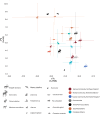Multi-species entanglements and stable isotope signals (δ13C and δ15N) in modern reindeer herding communities of boreal northeast Asia
- PMID: 40370022
- PMCID: PMC12079137
- DOI: 10.1098/rstb.2024.0203
Multi-species entanglements and stable isotope signals (δ13C and δ15N) in modern reindeer herding communities of boreal northeast Asia
Abstract
Prevailing anthropocentric frameworks of animal husbandry in archaeological research are increasingly critiqued for their inability to capture the full spectrum of human-non-human systems. In west Siberia and northern Mongolia, reindeer herding communities practise an entwined multi-species lifeways with the subarctic boreal and forest ecosystems-but these practices lack secure archaeological chronologies and time depth in northeast Asia. Traces of reindeer herding and reindeer remains themselves are often under-represented in the depositional record, requiring alternative avenues for tracing the archaeology of reindeer herding. Here, we explore the potential of documenting these complex dynamics archaeologically through a proof-of-concept analysis of stable isotopic carbon and nitrogen in faunal bone collagen, which can represent a possible nexus of multi-species practices. In doing so, we seek to expand investigative potentials into both human and non-human community members, providing valuable, nuanced insights into past practices, hunter-herder interactions and domestication dynamics.This article is part of the theme issue 'Unravelling domestication: multi-disciplinary perspectives on human and non-human relationships in the past, present and future'.
Keywords: Indigenous Knowledge; North Asia; dietary isotopes; multi-species; reindeer domestication.
Conflict of interest statement
We declare we have no competing interests.
Figures





Similar articles
-
Identification of working reindeer using palaeopathology and entheseal changes.Int J Paleopathol. 2020 Sep;30:57-67. doi: 10.1016/j.ijpp.2020.02.001. Epub 2020 May 25. Int J Paleopathol. 2020. PMID: 32464526
-
Investigating reindeer pastoralism and exploitation of high mountain zones in northern Mongolia through ice patch archaeology.PLoS One. 2019 Nov 20;14(11):e0224741. doi: 10.1371/journal.pone.0224741. eCollection 2019. PLoS One. 2019. PMID: 31747407 Free PMC article.
-
Reconstruction of human subsistence and husbandry strategies from the Iberian Early Neolithic: A stable isotope approach.Am J Phys Anthropol. 2018 Oct;167(2):257-271. doi: 10.1002/ajpa.23622. Epub 2018 Aug 20. Am J Phys Anthropol. 2018. PMID: 30129180
-
The sleeping crops of eastern North America: a new synthesis.Philos Trans R Soc Lond B Biol Sci. 2025 May;380(1926):20240192. doi: 10.1098/rstb.2024.0192. Epub 2025 May 15. Philos Trans R Soc Lond B Biol Sci. 2025. PMID: 40370024 Free PMC article. Review.
-
Effects of modern forest management on winter grazing resources for reindeer in Sweden.Ambio. 2010 Jun;39(4):269-78. doi: 10.1007/s13280-010-0044-1. Ambio. 2010. PMID: 20799676 Free PMC article. Review.
Cited by
-
Unravelling domestication: introduction to the theme issue.Philos Trans R Soc Lond B Biol Sci. 2025 May;380(1926):20240187. doi: 10.1098/rstb.2024.0187. Epub 2025 May 15. Philos Trans R Soc Lond B Biol Sci. 2025. PMID: 40370018 Free PMC article. No abstract available.
References
-
- Stépanoff C, Marchina C, Fossier C, Bureau N. 2017. Animal autonomy and intermittent coexistences: North Asian modes of herding. Curr. Anthropol. 58, 57–81. (10.1086/690120) - DOI
-
- Stépanoff C. 2017. The rise of reindeer pastoralism in Northern Eurasia: human and animal motivations entangled: the rise of reindeer pastoralism in northern Eurasia. J. R. Anthropol. Inst. 23, 376–396. (10.1111/1467-9655.12612_1) - DOI
-
- Golovnev AV. 2016. The Arctic nomads: strategies of mobility. Archaeol. Ethnol. Anthropol. Eurasia 44, 131–140. (10.17746/1563-0110.2016.44.4.131-140) - DOI
-
- Baskin LM. 2003. River crossings as principal points of human/reindeer relationship in Eurasia. Rangifer 23, 37. (10.7557/2.23.5.1653) - DOI
-
- Golovnev AV. 1999. Siberian survival: the nenets and their story. Ithaca, NY: Cornell University Press. (10.7591/j.ctv5qdg1n) - DOI
MeSH terms
Substances
Grants and funding
LinkOut - more resources
Full Text Sources
Miscellaneous

